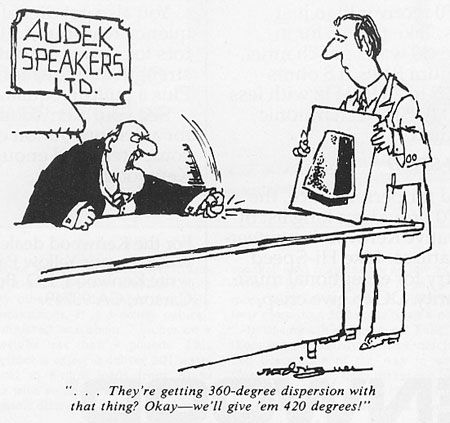Lies, damned lies and speaker efficiency!
By Roy Gregory

It’s a sad fact of human life that the more trivial the issue, the more violent the arguments it causes. Stereophile recently closed the comments facility on its online platform after repeated and unfounded accusations, slurs and threats of actual bodily harm. Really, it’s audio! But such immoderate behaviour has become so commonplace since the advent of the internet that it passes almost unnoticed. Woe betide the sports star who underperforms or makes a mistake. Lord help the audio commentator who offends some interest group or questions dogma online, opening the floodgates of knee-jerk responses set on hair triggers.
 Unfortunately, it’s a tendency that, in audio circles at least, is as unhelpful as it is unpleasant. Dogma stifles debate just as reductionist constructs blunt understanding, but those seeking audio enlightenment potentially get a double dose of disinformation, from the online dogma that shouts down all dissent and the marketing materials that scent opportunity. Companies with product to sell have ever loved a ‘silver bullet’ solution, just as magazines looking for copy, and audiophiles looking to buy, seek the ‘one great truth’. So, be it triodes or Class A amplification, horns or panels, diamond tweeters or ceramic cones, there always seems to be the latest, greatest, must have thing. Audio isn’t the fashion industry, but it certainly suffers the vicissitudes of fashion. Since the advent of the internet, the emergence of for a and their colonization by interest groups, those fashionable swings have become more hotly debated, entrenched and exaggerated. It’s nothing new, but the swings are greater and their frequency increasing – and they still have little to do with reality.
Unfortunately, it’s a tendency that, in audio circles at least, is as unhelpful as it is unpleasant. Dogma stifles debate just as reductionist constructs blunt understanding, but those seeking audio enlightenment potentially get a double dose of disinformation, from the online dogma that shouts down all dissent and the marketing materials that scent opportunity. Companies with product to sell have ever loved a ‘silver bullet’ solution, just as magazines looking for copy, and audiophiles looking to buy, seek the ‘one great truth’. So, be it triodes or Class A amplification, horns or panels, diamond tweeters or ceramic cones, there always seems to be the latest, greatest, must have thing. Audio isn’t the fashion industry, but it certainly suffers the vicissitudes of fashion. Since the advent of the internet, the emergence of for a and their colonization by interest groups, those fashionable swings have become more hotly debated, entrenched and exaggerated. It’s nothing new, but the swings are greater and their frequency increasing – and they still have little to do with reality.
Over the years we’ve seen different technologies and approaches find favour – and then fall by the wayside. We saw the three-point suspended sub-chassis turntable take the world by storm – crushing all competition. Another early example was the metal-dome tweeter: as soon as Celestion launched the SL6, at least in the UK, it became almost impossible to sell a speaker that didn’t have a metal dome. In the resulting rush to ‘upgrade’ competing models, many an excellent speaker was duly defaced and ruined. Diamond domes might also be added to the list – although they never achieved the decimating market impact of those original metal tweeters. From cabinet materials to designer components, tube types to circuit or PSU topologies, they come, they go and sometimes they come around, all over again.
The latest, long-term trend seems to be the rise and rise of speaker efficiency. These days, the most unlikely products are being presented by their manufacturers and/or the press as ‘high-efficiency’ designs, while the quoted efficiency figures for loudspeakers are becoming less and less reliable. On the one hand, there are vociferous online cheer-leaders, telling anybody who’ll listen or read that all you need to achieve audio Nirvana is a high-efficiency speaker (probably coupled to a flea-powered triode amplifier): on the other, there are a host of manufacturers telling potential buyers that that’s exactly what they’re offering. The problem is, that just like the advent of laser-interferometry and the ultra-flat frequency response designs it promoted, this situation risks becoming a developmental cul-de-sac, albeit for different reasons. In just the same way as designers started to use more and more heavy-handed crossovers to eliminate ripples in their pretty, measured read-outs (without considering the impact of those changes in terms of system performance), so the blind pursuit (or the illusory appearance) of speaker efficiency has its own implications.

